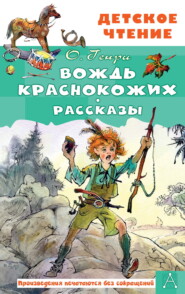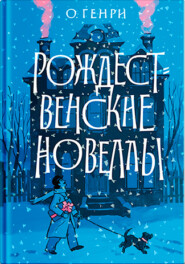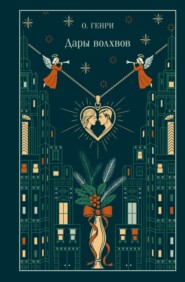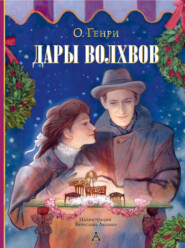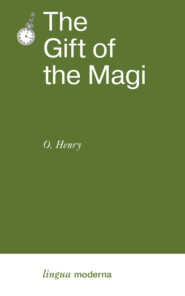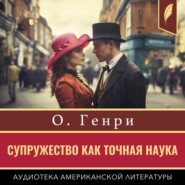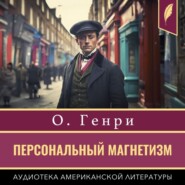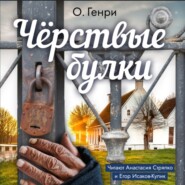По всем вопросам обращайтесь на: info@litportal.ru
(©) 2003-2024.
✖
Heart of the West [Annotated]
Настройки чтения
Размер шрифта
Высота строк
Поля
24
Grease-us– a play on the name of Croesus
25
Eighteenth Century mariners called the petrel (a large sea bird) "Mother Cary's chicken."
26
crack-loo– a form of gambling in which coins are tossed high into the air with the object having one's coin land nearest a crack in the floor
27
The Menger Hotel was (and still is) a San Antonio landmark. Built in 1859 near the Alamo, its guests have included Robert E. Lee, U. S. Grant, Theodore Roosevelt, and Sarah Bernhardt.
28
suaderos– O. Henry uses this term in several stories. He probably meant "sudaderos," which are saddle blankets or pads. The term is also sometimes used to refer to pads that prevent the stirrup straps from rubbing the rider's leg. O. Henry undoubtedly picked up the word during his stay on South Texas ranches, but he probably never saw the word written, and "suaderos" was what he came up with many years later when writing. This annotator is grateful to Michael K. DeWitt of Oklahoma State University for explaining this reference.
29
Cambon snack– This term eludes definitive explanation. It might refer to the brothers Paul and Jules Cambon. Paul was the French ambassador to Great Britain from 1898 to 1920; in 1904 he negotiated the Entente Cordiale between France and Britain that was the basis for their alliance in World War I. Jules was the French ambassador to the U.S. from 1897 to 1902 and was the French ambassador to Germany at the outbreak of World War I.
30
Sir Thomas Henry Hall Caine (1853-1931) was a very popular British novelist and playwright in his day, but his works have now been largely forgotten. As of July, 2004, two of his books, and , can be found in Project Gutenberg's library.
31
cicerone– a sight-seeing guide
32
suttee– the practice in India (now illegal) of a widow being burned to death (voluntarily or involuntarily) on her husband's funeral pyre
33
In the late 1800's and early 1900's western air was thought to be efficacious in healing tuberculosis (no drug therapy was then available), and many patients were sent to San Antonio. This theme appears in other O. Henry stories. There was a history of tuberculosis in O. Henry's family, and while he never had overt signs of the disease, he was allowed to go (or sent) to Texas at age 20 partly for his health.
34
Russell Sage (1815-1906) was a well-known wealthy New York businessman with financial interests in banking, western railroads, and Western Union.
35
mutoscope– In 1894 Henry Norton Marvin and Herman Casler patented the mutoscope, a device for showing moving pictures. A sequence of photographs was attached to a rotating drum, so that the images were flipped rapidly from one to the next as the drum rotated, creating the illusion of motion.
36
International– The International and Great Northern Railroad (I. & G. N.) plays a prominent role in many of O. Henry's stories. It was one of the great early railroads of Texas, beginning in the northeast corner of the state and gradually extending southwestward almost 600 miles, reaching Rockdale by 1873, Austin by 1876, then San Antonio, and eventually the Mexican border at Laredo in 1881. Later it became part of the Missouri Pacific system.
37
There is a town named Rincón almost 200 miles south of San Antonio, but it is not on the route of the I. & G. N. O. Henry often appropriated names of real places for his stories without worrying about geographical correctness. The description here is undoubtedly from O. Henry's memory of his journey from his home in North Carolina to a ranch in LaSalle County, Texas, when he was twenty. He would have gotten off the I. & G. N. at Cotulla, about 90 miles south of San Antonio, and ridden to the ranch as described in this paragraph. The description of this journey, with its vistas and aromas, is repeated in a number of O. Henry's stories.
38
javeli– native wild pigs of the Sonoran desert, more often called javelinas, prized by hunters because of their ferocity. Their name comes from the Spanish word for javelin, "jabalina," because of their razor-sharp teeth.
39
Drinking water was stored in clay containers in the shade. Water seeped through the clay to the surface, where it evaporated, and the evaporation cooled the jar and its contents.
40
señorito– (Spanish) young man, little man
41
Esta bueno?– (Spanish) Is that good? Is that all right?
42
mil gracias– (Spanish) a thousand thanks
43
kobold– in German folklore an elf or gnome who haunts underground places
44
gehenna– (Biblical) a place of abomination; Hell
45
The Guadalupe River arises in the Hill Country of Central Texas northwest of San Antonio and flows southeast to the Gulf of Mexico.
46
Another of O. Henry's lapses from geographical accuracy. The Guadalupe is much farther than twenty miles to the north and east from the setting of this story.
47
treinta, cuarenta– (Spanish) thirty, forty
48
rangers– Texas Rangers, an elite law-enforcement organization which began in the 1830's, even before Texas became an independent republic. One of O. Henry's hosts during his stay on ranches in South Texas was Leigh Hall, a man from O. Henry's home town in North Carolina, who had been one of the most famous Texas Rangers. Hall had resigned from the Rangers and was managing a ranch when O. Henry was taken to Texas by Hall's parents. Hall probably served as a model for many of O. Henry's Ranger heroes.
Grease-us– a play on the name of Croesus
25
Eighteenth Century mariners called the petrel (a large sea bird) "Mother Cary's chicken."
26
crack-loo– a form of gambling in which coins are tossed high into the air with the object having one's coin land nearest a crack in the floor
27
The Menger Hotel was (and still is) a San Antonio landmark. Built in 1859 near the Alamo, its guests have included Robert E. Lee, U. S. Grant, Theodore Roosevelt, and Sarah Bernhardt.
28
suaderos– O. Henry uses this term in several stories. He probably meant "sudaderos," which are saddle blankets or pads. The term is also sometimes used to refer to pads that prevent the stirrup straps from rubbing the rider's leg. O. Henry undoubtedly picked up the word during his stay on South Texas ranches, but he probably never saw the word written, and "suaderos" was what he came up with many years later when writing. This annotator is grateful to Michael K. DeWitt of Oklahoma State University for explaining this reference.
29
Cambon snack– This term eludes definitive explanation. It might refer to the brothers Paul and Jules Cambon. Paul was the French ambassador to Great Britain from 1898 to 1920; in 1904 he negotiated the Entente Cordiale between France and Britain that was the basis for their alliance in World War I. Jules was the French ambassador to the U.S. from 1897 to 1902 and was the French ambassador to Germany at the outbreak of World War I.
30
Sir Thomas Henry Hall Caine (1853-1931) was a very popular British novelist and playwright in his day, but his works have now been largely forgotten. As of July, 2004, two of his books, and , can be found in Project Gutenberg's library.
31
cicerone– a sight-seeing guide
32
suttee– the practice in India (now illegal) of a widow being burned to death (voluntarily or involuntarily) on her husband's funeral pyre
33
In the late 1800's and early 1900's western air was thought to be efficacious in healing tuberculosis (no drug therapy was then available), and many patients were sent to San Antonio. This theme appears in other O. Henry stories. There was a history of tuberculosis in O. Henry's family, and while he never had overt signs of the disease, he was allowed to go (or sent) to Texas at age 20 partly for his health.
34
Russell Sage (1815-1906) was a well-known wealthy New York businessman with financial interests in banking, western railroads, and Western Union.
35
mutoscope– In 1894 Henry Norton Marvin and Herman Casler patented the mutoscope, a device for showing moving pictures. A sequence of photographs was attached to a rotating drum, so that the images were flipped rapidly from one to the next as the drum rotated, creating the illusion of motion.
36
International– The International and Great Northern Railroad (I. & G. N.) plays a prominent role in many of O. Henry's stories. It was one of the great early railroads of Texas, beginning in the northeast corner of the state and gradually extending southwestward almost 600 miles, reaching Rockdale by 1873, Austin by 1876, then San Antonio, and eventually the Mexican border at Laredo in 1881. Later it became part of the Missouri Pacific system.
37
There is a town named Rincón almost 200 miles south of San Antonio, but it is not on the route of the I. & G. N. O. Henry often appropriated names of real places for his stories without worrying about geographical correctness. The description here is undoubtedly from O. Henry's memory of his journey from his home in North Carolina to a ranch in LaSalle County, Texas, when he was twenty. He would have gotten off the I. & G. N. at Cotulla, about 90 miles south of San Antonio, and ridden to the ranch as described in this paragraph. The description of this journey, with its vistas and aromas, is repeated in a number of O. Henry's stories.
38
javeli– native wild pigs of the Sonoran desert, more often called javelinas, prized by hunters because of their ferocity. Their name comes from the Spanish word for javelin, "jabalina," because of their razor-sharp teeth.
39
Drinking water was stored in clay containers in the shade. Water seeped through the clay to the surface, where it evaporated, and the evaporation cooled the jar and its contents.
40
señorito– (Spanish) young man, little man
41
Esta bueno?– (Spanish) Is that good? Is that all right?
42
mil gracias– (Spanish) a thousand thanks
43
kobold– in German folklore an elf or gnome who haunts underground places
44
gehenna– (Biblical) a place of abomination; Hell
45
The Guadalupe River arises in the Hill Country of Central Texas northwest of San Antonio and flows southeast to the Gulf of Mexico.
46
Another of O. Henry's lapses from geographical accuracy. The Guadalupe is much farther than twenty miles to the north and east from the setting of this story.
47
treinta, cuarenta– (Spanish) thirty, forty
48
rangers– Texas Rangers, an elite law-enforcement organization which began in the 1830's, even before Texas became an independent republic. One of O. Henry's hosts during his stay on ranches in South Texas was Leigh Hall, a man from O. Henry's home town in North Carolina, who had been one of the most famous Texas Rangers. Hall had resigned from the Rangers and was managing a ranch when O. Henry was taken to Texas by Hall's parents. Hall probably served as a model for many of O. Henry's Ranger heroes.






